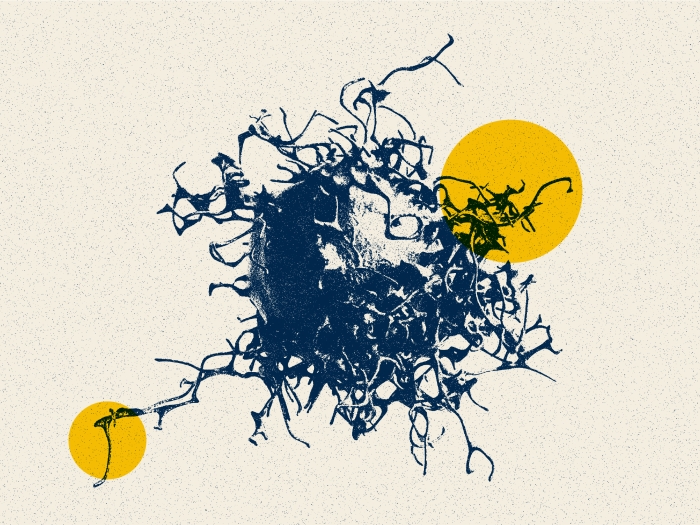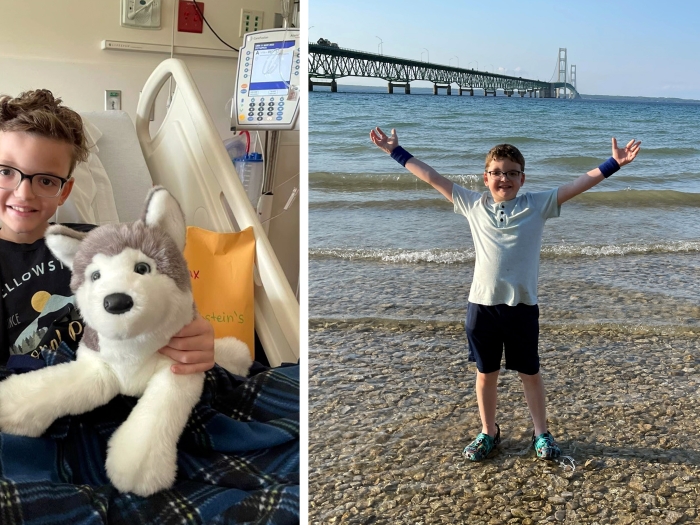At Sophie’s Place, music therapy brings joy to patients, families and therapists alike
11:18 AM
Author |
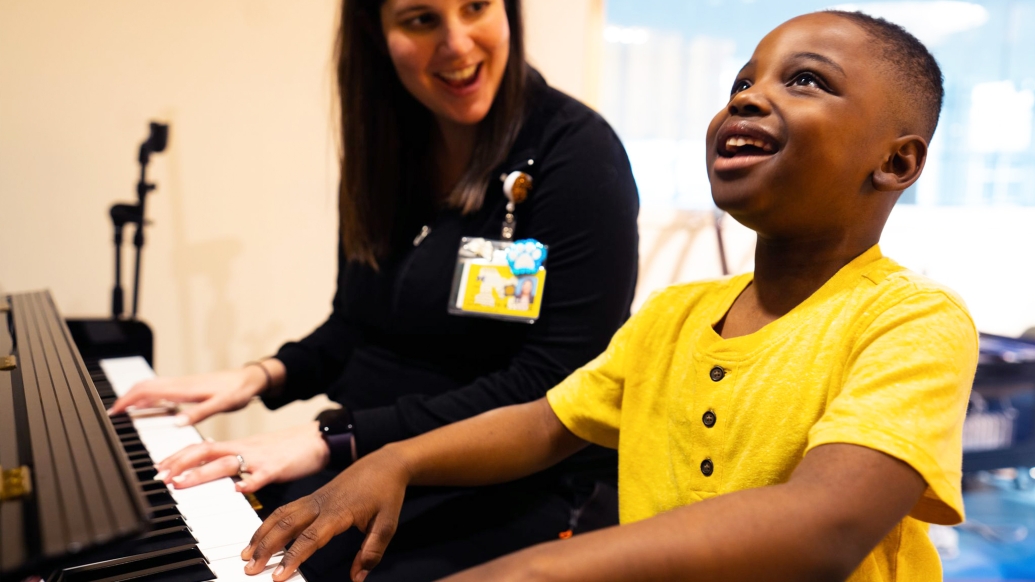
Tucked away in the corner of University of Michigan Health C.S. Mott Children’s Hospital is Sophie’s Place, a bright, comfortable studio that’s brought peace to many patients and their families since its grand opening last year.
Sophie’s Place, named for young singer-songwriter Sophie Rose Barton, opened in August 2022. Its team of dedicated, board certified music therapists promote creative expression, safety and comfort for patients and families throughout their time at Mott. Studio manager Meredith Irvine says music therapy can be part of a patient’s healthcare journey regardless of the trajectory; she and the other therapists love bringing “something unique and amazing” to everyone who comes through the doors.
“The value of music therapy really starts with how music is a part of our being and our culture as humans. It’s something we’re surrounded by from a young age, all the way through adulthood,” Irvine said. “It’s natural that when patients and families are in the hospital, music can be one of those aspects that is calming, soothing, a connector to other people, and something they can relate to right away.”
Feeling “free”
Music therapist Erica Ginepro and patient Jimmy Wolfe. Jimmy has been coming to Sophie’s place for several months after getting a port installed in his chest. In August 2022, Jimmy was diagnosed with Blastic Plasmacytoid Dendritic Cell Neoplasm, or BPDCN, a rare and aggressive form of Acute Myeloid Leukemia. He had a bone marrow transplant in December of 2022.
Jimmy and Ginepro, guitars in hand, rehearse for Jimmy’s performance at VictorThon, the culminating event for University of Michigan’s Dance Marathon. They’re playing “Free” by Zac Brown Band, which Jimmy says is a song close to his and his family’s hearts. He wants to be a country music star someday and is apparently well on his way to this goal: he’s already recorded 10 songs, enough for his own album, in the recording studio at Sophie’s Place.
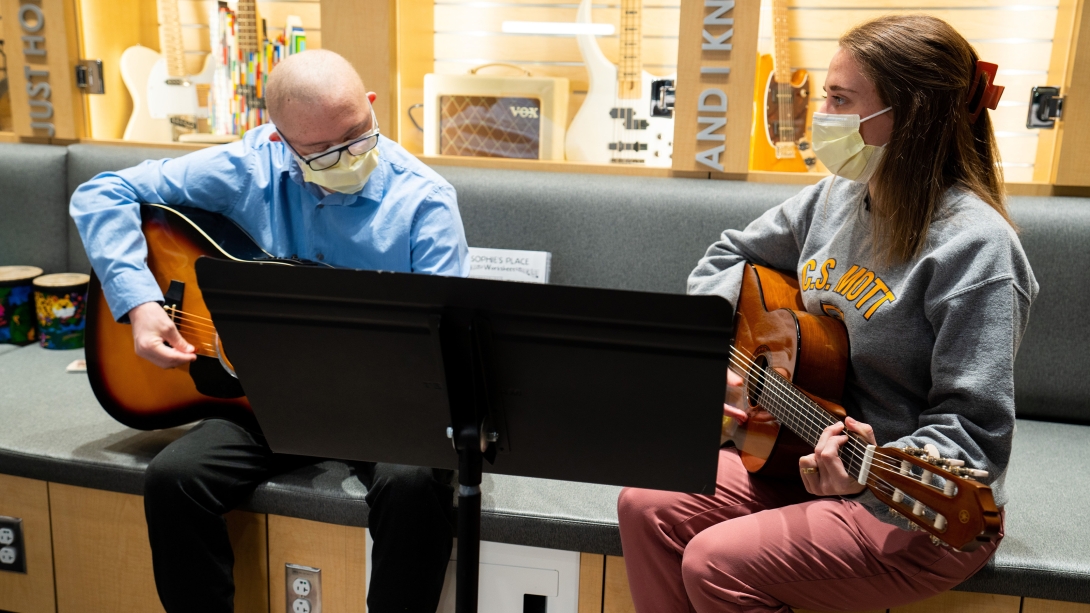
“I love to make music. It feels awesome to record a song,” Jimmy said.
Ginepro says Jimmy is an excellent advocate for himself and always knows exactly what he wants to do when he comes in for his sessions. She sees the value of music therapy for Jimmy and so many other patients.
“We’re so privileged to have Sophie’s Place here, and to have the team of music therapists that we do. It’s hard to be in a hospital room 24/7, so this is a nice safe space for patients and families to come for some respite,” Ginepro said. “I feel grateful to do the work I do every day, and people like Jimmy make it worth it.”
Musical healing for the youngest babies
In the Brandon Neonatal Intensive Care Unit, music therapist Holly Gibes visits patient Josephine Temple. Josephine’s mother Sara Temple is a singer herself and harmonizes with Gibes. Josephine relaxes in her mom’s arms, moving her fingers and mouth as the two women sing along with Gibes’ guitar.
Josephine’s reactions and indicators of positive stimulation are good signs to Gibes, who closely observes her patients in the NICU. She watches their vital signs to ensure they’re maintaining proper oxygen levels and heart rates, and only does what is appropriate for each patient’s gestational age. Music therapy can begin at 28 weeks, the youngest when a baby’s hearing is fully developed, and advances as the babies grow. Gibes also notes that it’s important to observe what each patient can handle during sessions.
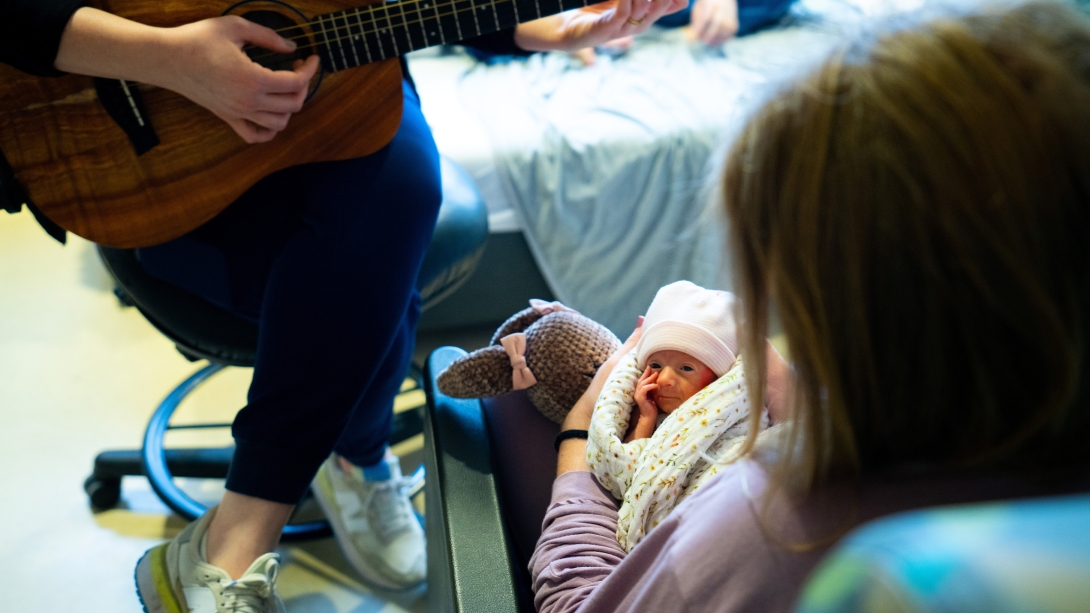
“Everything I do is baby-led. If a baby is too sensitive on a day, we won’t do therapy or I’ll stop it short,” Gibes said. “It’s a progression that we work on their whole time here.”
Sara Temple said Holly “brings peace” to the rooms of the NICU.
“From what I have observed, Josephine really enjoys when Holly comes to visit. She just gets really relaxed and does new things with her mouth that we’ve never seen before,” she said, smiling at her daughter. “I think it’s a wonderful service that Michigan Medicine provides.”
The movement of Josephine's mouth is called rooting, and is a sign that she is developmentally getting ready for a pacifier. Suck, Swallow and Breath is something premature babies need to learn in order to eat, and very important for their development. Rooting is a positive reaction to stimulation and is something that Gibes is watching for during sessions. Other examples of positive stimulation are eye contact, babies turning their head towards the music, cuddling, coo'ing and falling asleep.
“There’s nothing better than seeing a family at the end of their journey and knowing how you’ve walked through with them,” she says. “It’s the best feeling in the world.”
– Holly Gibes
Also receiving music therapy from Gibes in the NICU is Evelyn Lucas and mom Ashley Lucas. Evelyn is at a stage in her therapy where additional positive stimulation, like touch, can be paired with music. Evelyn’s hands are placed on Gibes’ guitar, letting her feel the source of the music she hears. Gibes at one point jokes that Evelyn untuned the guitar.
Once the strings are back in tune, Evelyn sits in her mom’s lap alongside a stuffed penguin, listening intently as Gibes plays a song she wrote with Evelyn’s mom. The lyrics promise Evelyn that she’s “a fighter, big and strong,” and “we are here, fighting alongside you.”
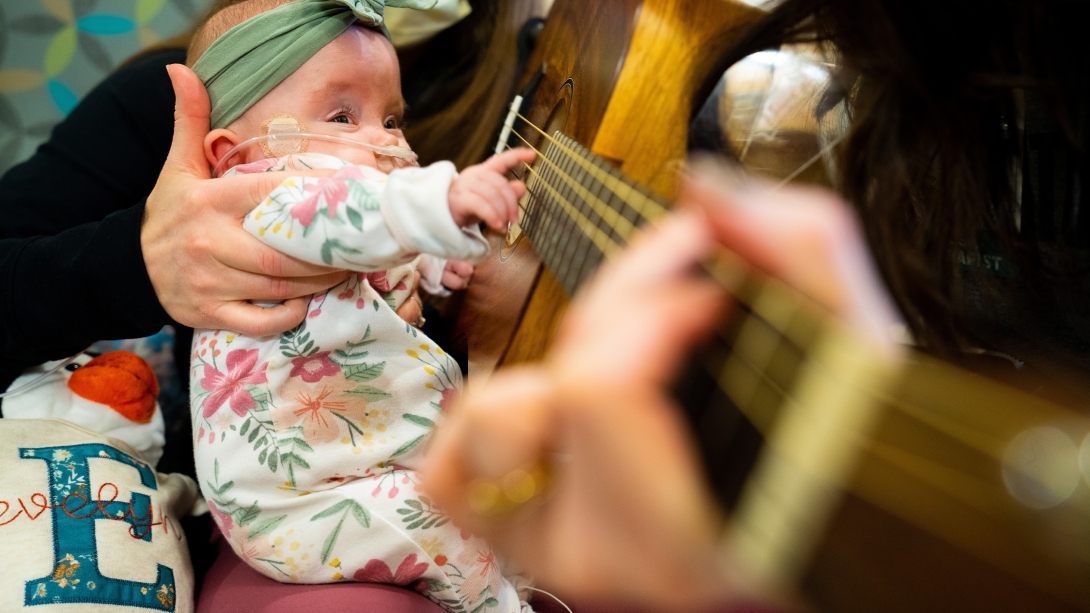
“We love Holly. She’s been a very comforting part of Evelyn’s journey for all of us,” Ashley Lucas said.
Supporting families is one of Gibes’ favorite parts of her job. She enjoys watching each patient’s progress and getting to know their families every step of the way.
“There’s nothing better than seeing a family at the end of their journey and knowing how you’ve walked through with them,” she says. “It’s the best feeling in the world.”
Creating fun and connection with music
Music therapist Maleea Roy and patient Mya Ferguson have had very active sessions – Mya always excitedly explores the room, moving from one instrument to another. She sings and plays with shakers, drums, ukeleles, keyboards and more as she and Roy dance around the room.
“I could just see how much Mya lit up when she played music. It was one of those experiences where you just knew that music was the thing helping her cope with her hospitalization,” Roy said. “We have a really good therapeutic relationship and connection. That’s a big reason I do music therapy – to create those connections with my patients and hopefully be a brighter spot in their day. What better way to do that than with music?”
Mya was diagnosed with sickle cell disease and needed a bone marrow transplant, and her older sister donated bone marrow for her procedure. Her mother, LaTrisha Ferguson, says music therapy has brought joy to Mya since her first session – she notes that Roy once brought a keyboard to Mya when she couldn’t leave her room.
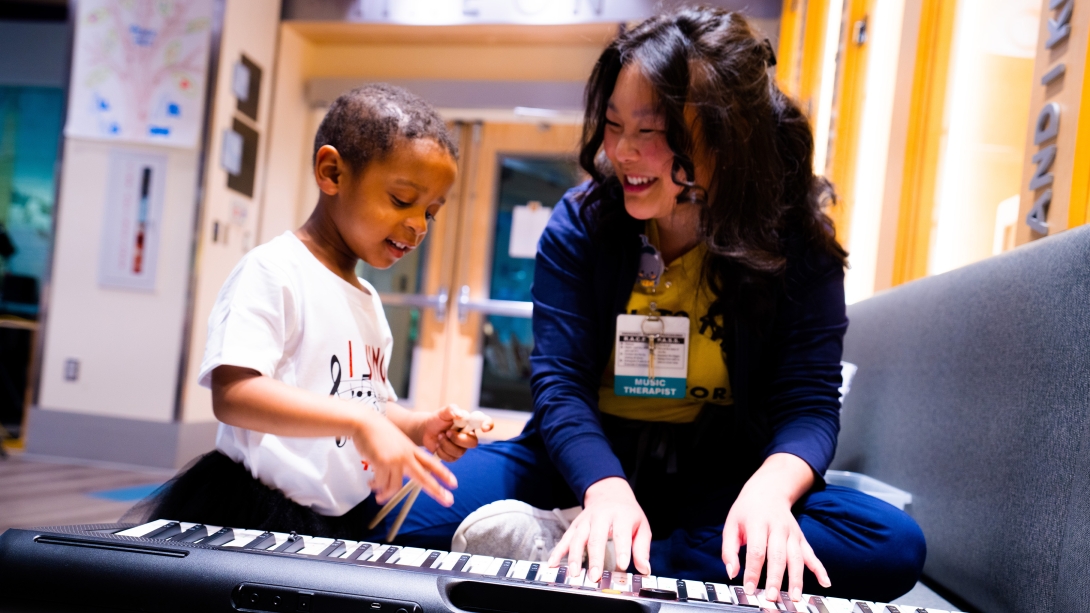
“It makes our day to see my baby girl brighten up when Maleea walks in, even after getting her first surgery and every time even after she got her chemo,” she said. “This whole experience has been beyond beautiful.”
Bringing joy during hospital stays
Much like Mya, patient Beau Copeland is eager to get into the instruments as he arrives for his session with Irvine. The two sit together at the piano for spirited iterations of the ABCs and “Twinkle, Twinkle Little Star” before moving on to guitars and drums on the floor.
“I’ve loved watching how much Beau has grown in music therapy,” Irvine said. “The way he’s using expressive language is a testament to how music has helped his development.”
Beau’s family learned of music therapy when he was on dialysis. Irvine and other therapists would come to his room and play music for him during his hours-long treatments. Beau’s mother, Maleah Copeland, says Beau was already in love with music: he wakes up singing and goes to bed singing.
“They would keep him comfortable. It brought him so much joy and happiness to be able do something fun when he was having to do something not so fun with his body,” she said. “It’s amazing what music therapy does for him, and I’m sure for a lot of kids. I can’t even put it into words.”
Beau, however, had no trouble coming up with words: “I love music!”

Explore a variety of healthcare news & stories by visiting the Health Lab home page for more articles.

Department of Communication at Michigan Medicine
Want top health & research news weekly? Sign up for Health Lab’s newsletters today!




